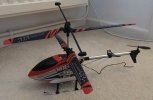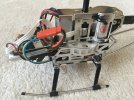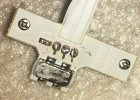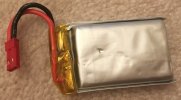Black Hole
May contain traces of nut
Anybody into RC modelling?
I've got a large-ish toy RC helicopter of the twin counter-rotating gyro-stabilised rotors variety. Yaw is controlled by slowing down one of the main rotors, pitch is controlled by a tiny vertical-axis tail rotor (and roll looks after itself). For scale, the main rotors are about 12" diameter.
I've had it a few years, must have picked it up on offer at Lidl I think.

Pretty quickly I discovered I need a large indoor space, or a very calm day outdoors, to fly it. There's not enough room in my house to lift off and control the drift in time for it not to bump into something. Thus it doesn't get flown very often at all.
Today there's snow on the ground and no wind at all, and covid so nothing is pressing. Get the chopper out (oo-er missus).
The problem is: it wouldn't take off. With the "gas" control at max, it just about managed to skim across the ground. Yes, it was freshly charged (LiPo, I assume).
I thought that, cold air being denser, it should get more lift not less.
Do LiPos age? I don't think it was exposed to the cold long enough for the LiPos to chill, but the only idea I have is internal resistance limiting the current available to the lift motors.
I've got a large-ish toy RC helicopter of the twin counter-rotating gyro-stabilised rotors variety. Yaw is controlled by slowing down one of the main rotors, pitch is controlled by a tiny vertical-axis tail rotor (and roll looks after itself). For scale, the main rotors are about 12" diameter.
I've had it a few years, must have picked it up on offer at Lidl I think.

Pretty quickly I discovered I need a large indoor space, or a very calm day outdoors, to fly it. There's not enough room in my house to lift off and control the drift in time for it not to bump into something. Thus it doesn't get flown very often at all.
Today there's snow on the ground and no wind at all, and covid so nothing is pressing. Get the chopper out (oo-er missus).
The problem is: it wouldn't take off. With the "gas" control at max, it just about managed to skim across the ground. Yes, it was freshly charged (LiPo, I assume).
I thought that, cold air being denser, it should get more lift not less.
Do LiPos age? I don't think it was exposed to the cold long enough for the LiPos to chill, but the only idea I have is internal resistance limiting the current available to the lift motors.






